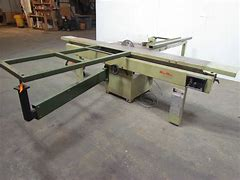- Joined
- Feb 1, 2015
- Messages
- 9,578
I bought my Montgomery Wards radial arm saw in 1968 and still use it. It originally was configured for a 9" blade but it accepted a 10" blade which is what I use. It is capable of cutting a 24" width and a depth of almost 4". I have a 10" hybrid table saw and a 10" compound miter saw but for cutting boards to precise length, the radial arm saw excels. The compound miter saw has too small a platform to be useful for larger pieces and a table saw is virtually useless for cutting longer boards to a precise length. A cut line is clearly visible on a radial arm saw whereas a table saw cuts from the bottom first so precise alignment is more of a challenge.
One thing to remember when making cuts like dados is that a table saw references the front side of the piece while a radial arm saw referneces the front side. This can make a difference when the boards are not uniform in thickness. Of course, a compound miter saw can't make dados at all.
Each of these saw has their own strong points as well as weak points. I bought a compound miter saw because I had two rooms of trim to install and I could bring the saw to the work site rather than running back and forth to the shop. The compound miter also excels in changing cut angles easily. For handling plywood, I prefer my table saw. For framing, my go to saw is the radial arm.
As to safety, I would list my radial arm saw first. As a teenager, I had forty sitches in my right hand from a table saw and I still tense up whenever I have to bring my hand close to the blade. The one I fear the most though is the compound miter. Cutting a 45º miter on a three inch piece of trim brings my hand very uncomfortably close to that blade and because of that, I would rate it as most dangerous.
One thing to remember when making cuts like dados is that a table saw references the front side of the piece while a radial arm saw referneces the front side. This can make a difference when the boards are not uniform in thickness. Of course, a compound miter saw can't make dados at all.
Each of these saw has their own strong points as well as weak points. I bought a compound miter saw because I had two rooms of trim to install and I could bring the saw to the work site rather than running back and forth to the shop. The compound miter also excels in changing cut angles easily. For handling plywood, I prefer my table saw. For framing, my go to saw is the radial arm.
As to safety, I would list my radial arm saw first. As a teenager, I had forty sitches in my right hand from a table saw and I still tense up whenever I have to bring my hand close to the blade. The one I fear the most though is the compound miter. Cutting a 45º miter on a three inch piece of trim brings my hand very uncomfortably close to that blade and because of that, I would rate it as most dangerous.


